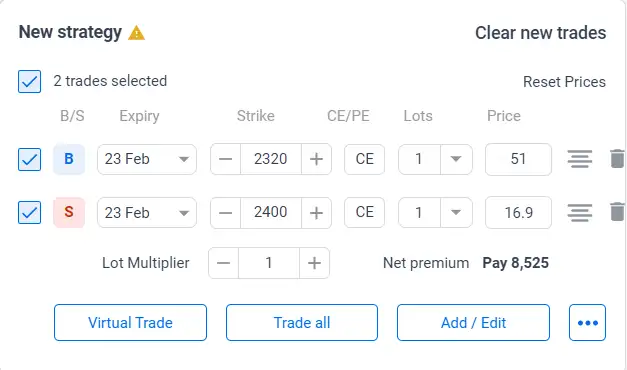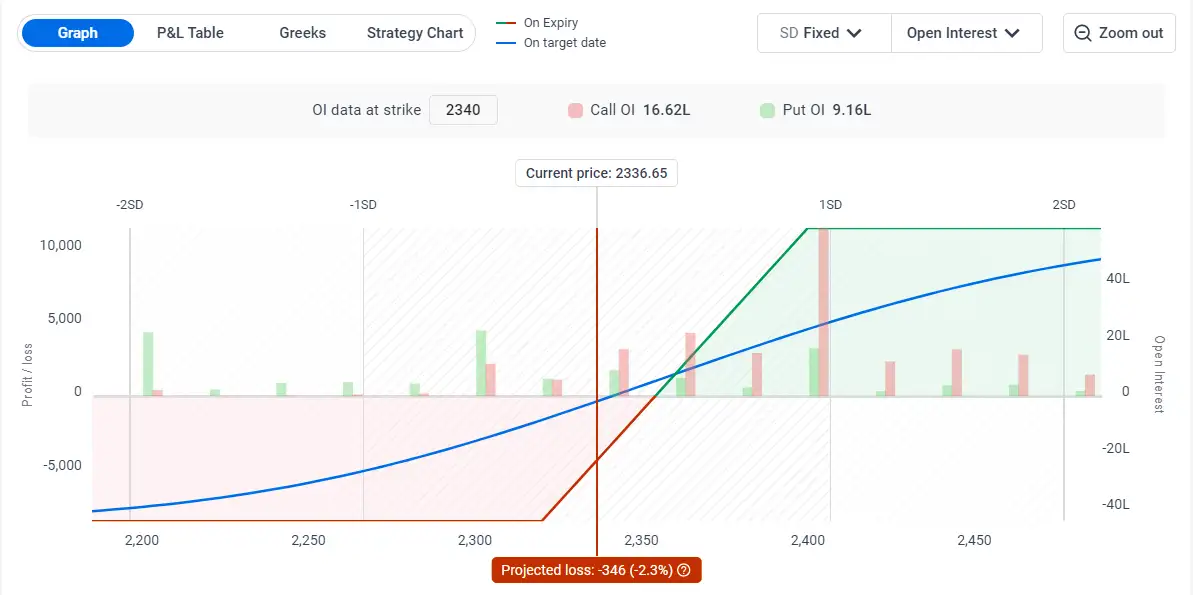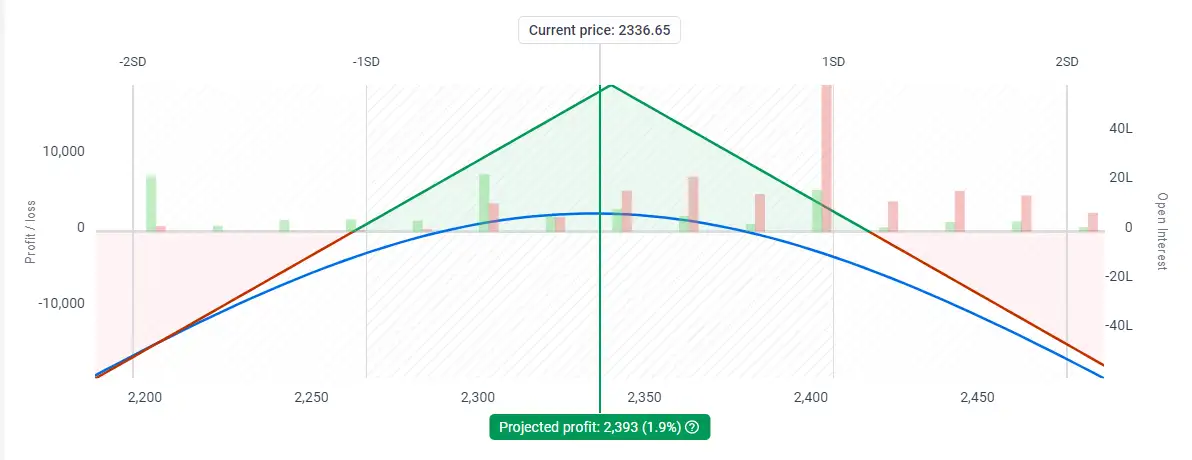- Vertical spreads – These are structures consisting of two options of an underlying with the same expiration. These are risk-defined strategies that can be created with either call options or put options to trade bullish or bearish views.
- Bull Call Spread – As the name suggests, it’s a bullish strategy created with call options. In this case, you buy one call option (preferably ATM or ITM) and simultaneously sell an OTM strike call option. The trade makes money if the underlying goes up and will lose otherwise. In the example shown below for industries which are trading at 2336, a slight ITM call option of strike 2320 is bought and 2400 is sold. The maximum risk in the trade is the debit paid which in this case is 34.1 (51-16.9). Reliance lot size is 250 so the max risk is 34.1*250 or Rs. 8525. The maximum profit potential is the difference between the 2 strikes distance and the debit paid which in this case is 80 – 34.1 or 45.9 and multiplying it by the lot size gives us a maximum profit potential of Rs. 11,475
 ETMarkets.com
ETMarkets.com ETMarkets.com
ETMarkets.com
 ETMarkets.com
ETMarkets.comb. Bull Put spread – Again as the name suggests, it’s a bullish structure created with put options. Here, a put option (preferably ATM/ITM) is sold and a lower strike put option is sold. For the same Reliance example, a put option of 2340 can be sold and 2260 put can be bought which will result in the desired structure of bull put spread. The main difference between a bull call spread and a bull put spread is the risk-reward ratio and probability of profit (POP). In a bull call spread, your POP goes down but the reward is higher compared to the risk. In a bull put spread, you’d risk a bit more to get the extra cushion on the probability of the trade working in your favor of you.
 ETMarkets.com
ETMarkets.com ETMarkets.com
ETMarkets.com
 ETMarkets.com
ETMarkets.com- Bear Put Spread and Bear Call Spread – Just the way we saw bullish options structures with call/put options, in a similar way bearish options structures can be created. So a bear put spread will be to buy an ATM/ITM put option and simultaneously sell an OTM put option. And a bear call spread is to sell an ATM/ITM call option and simultaneously buy an OTM call option.
Note –
- Vertical spreads work well in both high and low-volatility markets. Look to create credit spreads (bear call spread or bull put spread) during a high volatility period and debit spreads (bull call spread or bear put spread) during a low volatility period.
- Spreads should not be created too close to expiry (4-5 days to expiry for stock options) as the OTM options don’t have much value so risk reward might not be favorable.
- Target and stop loss for the spreads can be kept based on the underlying as well as on the spread itself. Look to book the spreads for 30-50% of the maximum theoretical profit/loss.
2. Straddle – Straddle is an ATM call and put option combined. Trading straddles is a non-directional strategy where the view is more on the volatility. If you expect the volatility to go down without much directional move in the underlying, a short straddle (selling ATM call and put option both) can be created. Similarly, if you expect the volatility to go up or a big move in the underlying on either side, a long straddle (buying ATM call and put option both) can be created. Below is the short straddle strategy and the payoff for Reliance Industries with both 2340 call and put options sold. Note that short straddles are an unlimited risk strategy on both sides and so position size should be kept in check while trading short straddles. If you want to make this short straddle trade risk defined, OTM options can be bought on both sides which will act as a hedge and the trade will be risk defined. The new structure created this way is called an iron fly.
Short straddles work well in the falling volatility environment and the long straddles would do well in a rising vol regime.
 ETMarkets.com
ETMarkets.com ETMarkets.com
ETMarkets.com
 ETMarkets.com
ETMarkets.com3. Strangles – Similar to straddles, strangles are non-directional strategies but instead of ATM options, it works with OTM options. Usually, strangles are traded on the short side i.e. the view is of volatility to go down and the underlying to remain range bound. For stock options, OTM options decay is faster compared to OTM when there is more time to expiry i.e. 20-30 trading sessions, and short strangle works well. Note that just like a short straddle, a short strangle is an unlimited risk strategy on both sides. If further OTM options are bought as a hedge to define risk on both sides, it results in a strategy called an iron condor. Below are the details of the short strangle strategy along with payoffs.
 ETMarkets.com
ETMarkets.com(Disclaimer: Recommendations, suggestions, views, and opinions given by the experts are their own. These do not represent the views of The Economic Times)









